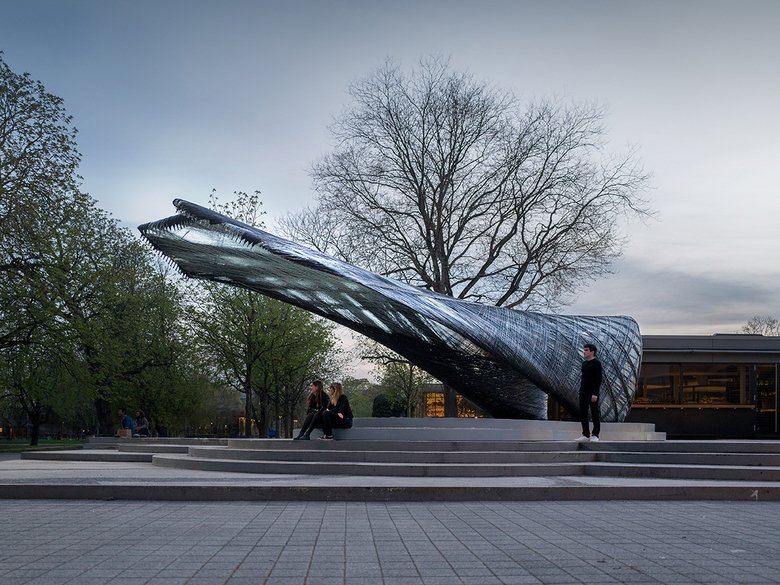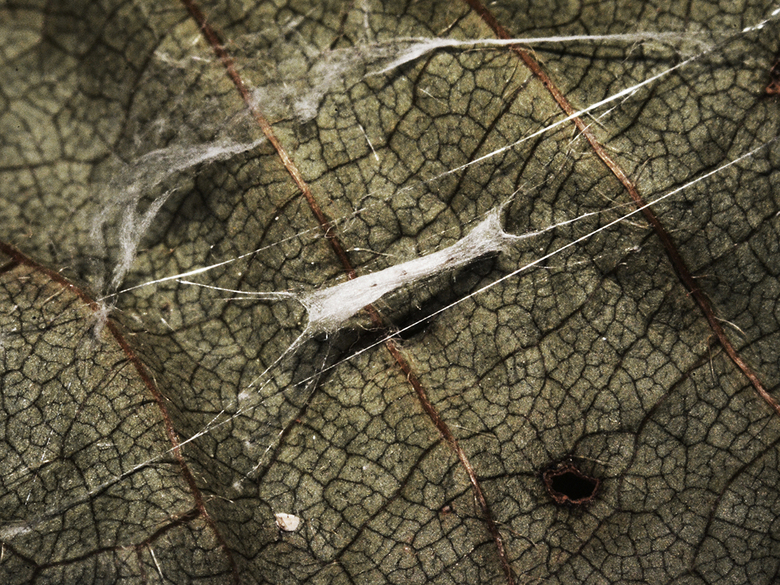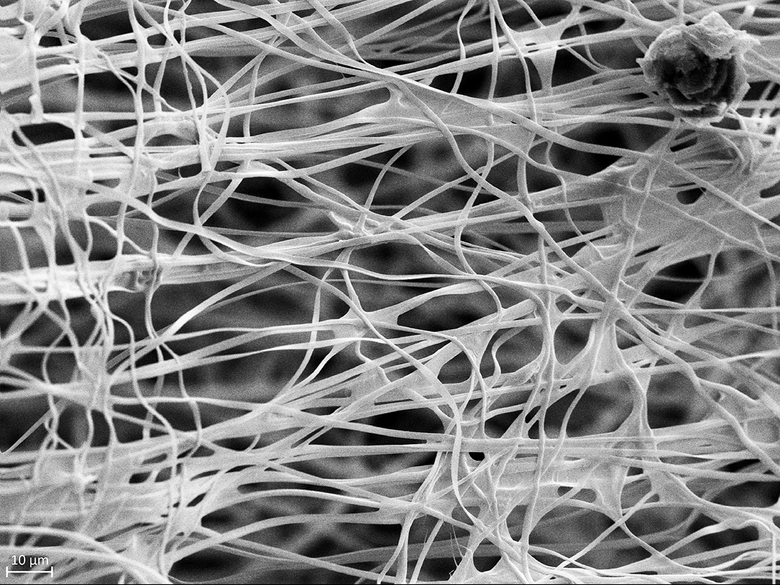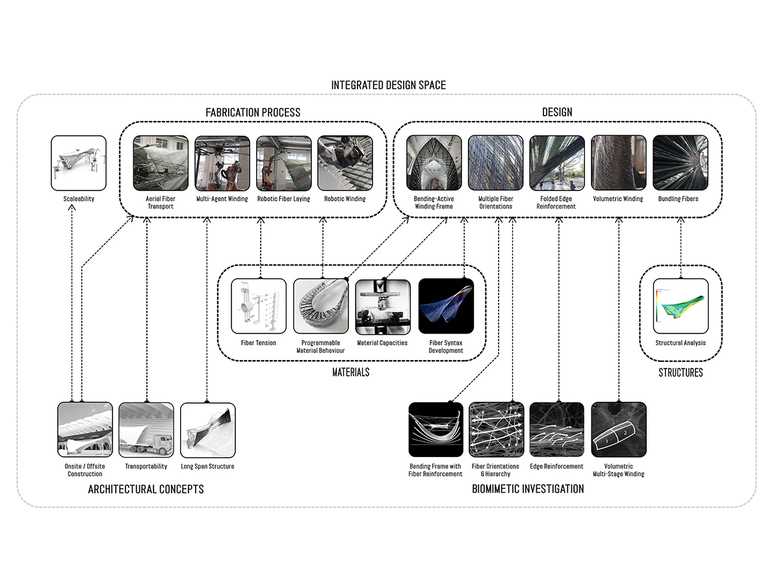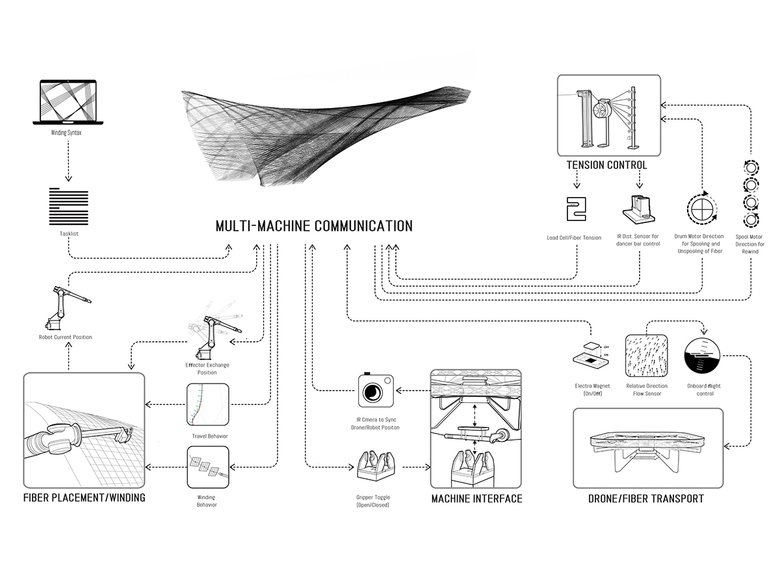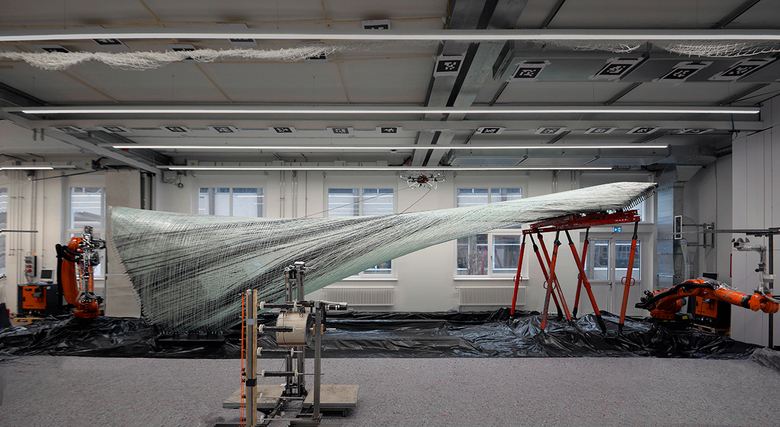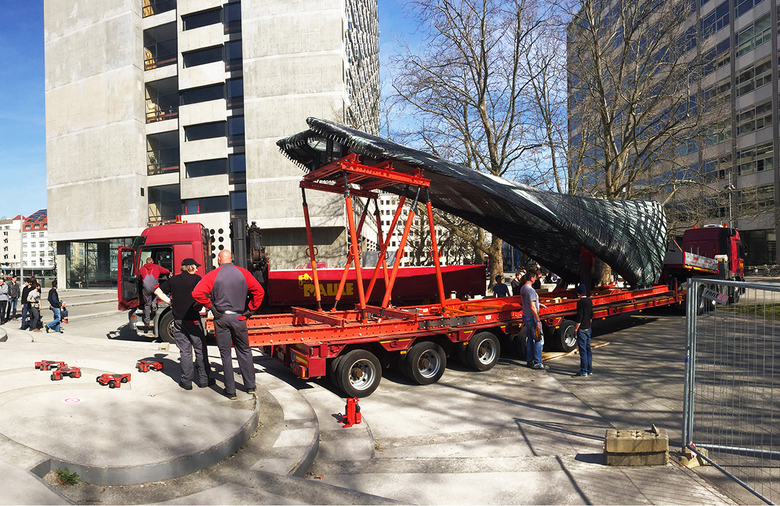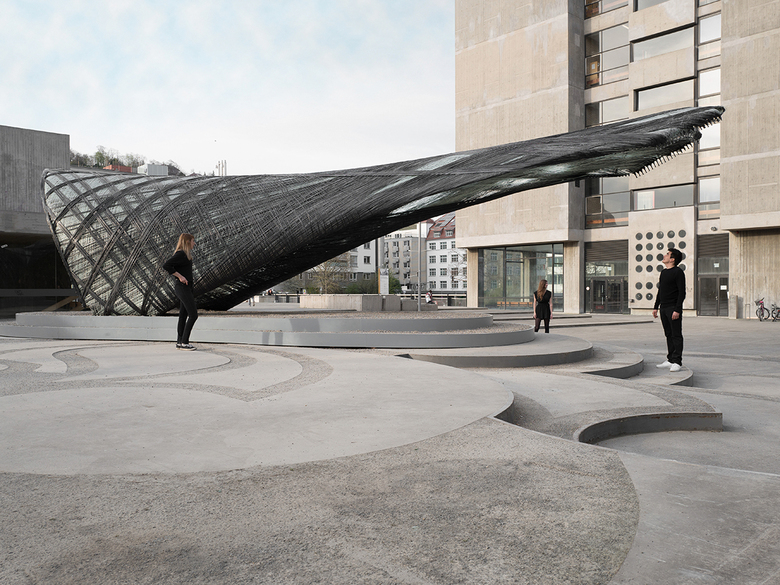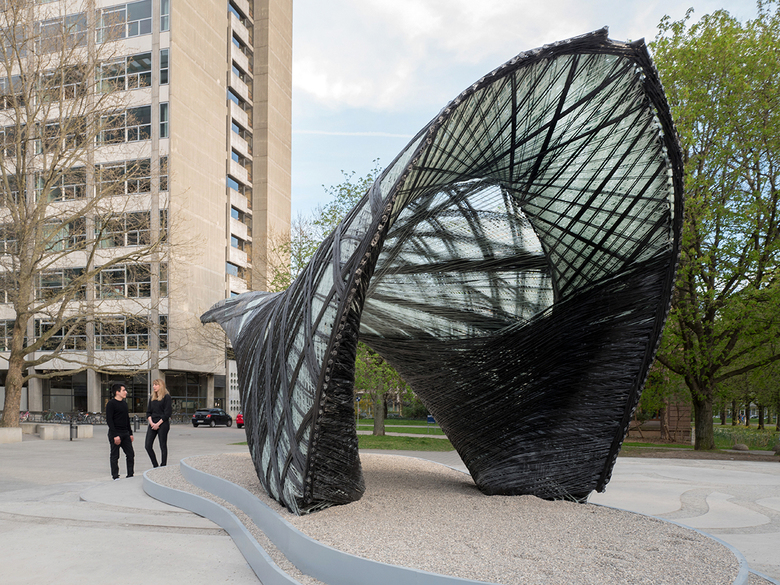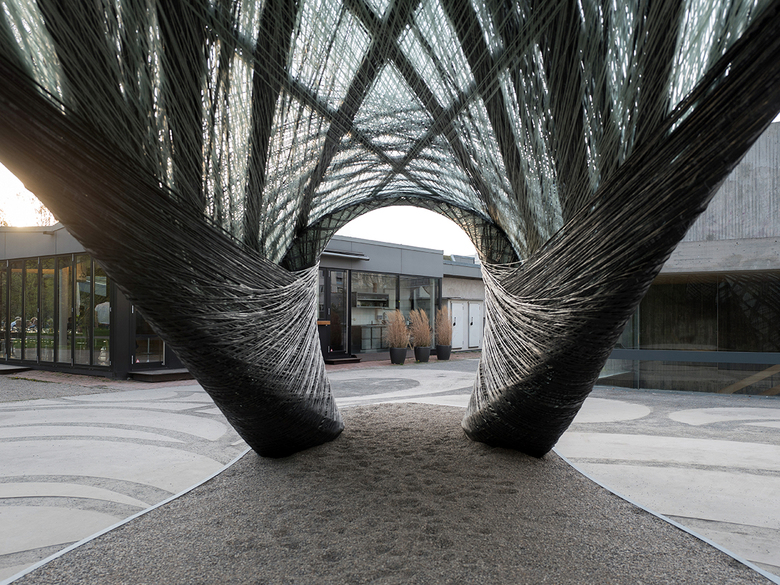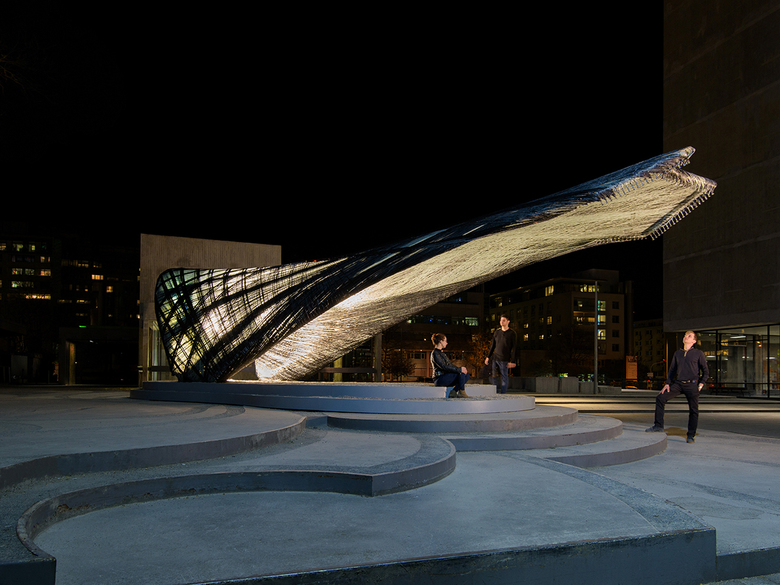21. April 2017
© ICD/ITKE, Photograph by Burggraf / Reichert
The Institute for Computational Design and Construction (ICD) and the Institute of Building Structures and Structural Design (ITKE) at the University of Stuttgart have completed a new research pavilion that breaks ground through its robotic fabrication of glass and carbon fiber-reinforced composites.
Previously we featured a couple ICD/ITKE collaborations that also involved carbon fiber structures: the Research Pavilion 2014-15, which was based on the nests of underwater spiders; and the Elytra Filament Pavilion, which used flying beetles for inspiration. The ICD/ITKE Research Pavilion 2016-17 likewise looks to nature, specifically two species of leaf miner moths – Lyonetia clerkella and Leucoptera erythrinella – that spin silk "hammocks" stretched between connection points on a bent leaf.
Lyonetia prunifoliell, “Apple Leaf Miner” cocoon (Photo: ©ICD/ITKE)
Under Achim Menges at ICD and Jan Knippers at ITKE, the project aimed to discover a fiber winding technique that could span a large distance without the need for much formwork. (The 2014-15 pavilion's shell, for instance, required a pneumatic formwork.) The two moth species, discovered in cooperation with the Institute of Evolution and Ecology and the department for Paleobiology of the University of Tübingen, provided principles that could be applied to the project's goals. Through biomimetic investigation, several ideas were taken from studying the moths and applied to the project's fabrication and structure: "the combination of a bending-active substructure and coreless wound fiber reinforcement to create an integrated composite winding frame, fiber orientation and hierarchy over a long span structure, and multi-stage volumetric fiber laying processes for the generation of complex three dimensional geometries," as described by ICD/ITKE.
Microscopic image of “Apple Leaf Miner” cocoon, illustrating fiber hierarchy and directionality (Photo: © ICD/ITKE)
Biomimicry may have influenced the pavilion's design, but when it came time to fabricate the 12-meter-long construction the team focused on robotic systems. Having used industrial robotic arms for fiber laying on previous pavilions, Menges and Knippers understood their strengths and weaknesses. Respectively, the robots are strong and precise, but they are limited in movement, making them insufficient for longspan structures. To overcome this, they paired two robotic arms with a custom-built unmanned aerial vehicle (UAV, aka a drone).
Diagram of integrated design space (Image: © ICD/ITKE)
Diagram of multi-machine communication for long-span fiber winding process (Image: © ICD/ITKE)
The off-site fabrication consisted of four main elements: two industrial robot arms placed at the ends of the structure (the cantilevered end propped up by minimal formwork), the autonomous UAV passing the fiber from one side to the other, and a tension control mechanism that responded to the UAV and robots. Further, a couple armatures and an integrated sensor interface enabled the robots and UAV to interact, passing the fiber back and forth. (The video below illustrates the fabrication process very well.) ICD/ITKE is hoping these elements lay the foundation for further explorations of what they describe as "novel multi-machine, cyber-physical fabrication processes for large scale fiber composite production."
Multi-machine fabrication setup utilizing two robotic arms and an autonomous drone (Image: © ICD/ITKE)
Fabrication setup of fiber winding robotic arms and autonomous drone carrying a fiber (Photo: © ICD/ITKE)
The pavilion may have surpassed its 12-meter length if it were fabricated on site, but given the off-site fabrication the lightweight structure had to be sized for transport – all in one go given the wound-fiber construction. Nevertheless, the latest ICD/ITKE creation is an impressive one, like something from a not-too-distant future, when nature is the model and technology is the tool for shaping our environment.
Unloading of long-span fiber composite structure onsite (Photo: © ICD/ITKE)
©ICD/ITKE, Photograph by Burggraf / Reichert
©ICD/ITKE, Photograph by Burggraf / Reichert
©ICD/ITKE, Photograph by Burggraf / Reichert
©ICD/ITKE, Photograph by Burggraf / Reichert
©ICD/ITKE, Photograph by Burggraf / Reichert
PROJECT DETAILS
Location
Keplerstr. 11-17, 70174 Stuttgart
Completion
March 2017
Project Team
ICD Institute for Computational Design and Construction (Prof. Achim Menges)
ITKE Institute of Building Structures and Structural Design (Prof. Jan Knippers)
Scientific Development
Benjamin Felbrich, Nikolas Früh, Marshall Prado, Sam Saffarian, James Solly, Daniel Reist, Lauren Vasey
System Development, Fabrication and Construction
Miguel Aflalo, Bahar Al Bahar, Lotte Aldinger, Chris Arias, Léonard Balas, Jingcheng Chen, Federico Forestiero, Dominga Garufi, Pedro Giachini, Kyriaki Goti, Sachin Gupta, Olga Kalina, Shir Katz, Bruno Knychalla, Shamil Lallani, Patricio Lara, Ayoub Lharchi, Dongyuan Liu, Yencheng Lu, Georgia Margariti, Alexandre Mballa, Behrooz Tahanzadeh, Hans Jakob Wagner, Benedikt Wannemacher, Nikolaos Xenos, Andre Zolnerkevic, Paula Baptista, Kevin Croneigh, Tatsunori Shibuya, Nicoló Temperi, Manon Uhlen, Li Wenhan. With the support of Artyom Maxim and Michael Preisack.
Collaborators
Institute of Aircraft Design (IFB): Prof. Dr.-Ing. P. Middendorf, Markus Blandl, Florian Gnädinger
Institute of Engineering Geodesy (IIGS): Prof. Dr.-Ing. habil. Volker Schwieger, Otto Lerke
Department of Evolutionary Biology of Invertebrates, University of Tuebingen: Prof. Oliver Betz
Department of Palaeontology of Invertebrates, University of Tuebingen: Prof. James Nebelsick
Area
26.5 m2
Volume
58 m3
Fiber Length
184 km
Weight
1000 Kg
Overall dimensions
12.0m x 2.6m x 3.1m
Related articles
-
A Cantilever Pointing to the Future
on 4/21/17
